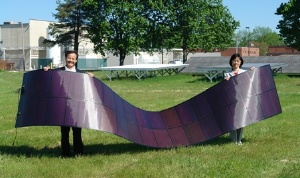May 27 2009
Xunlight Corporation, a leader in the development of flexible and lightweight thin-film silicon solar modules, announced today that it has successfully demonstrated its high-throughput, wide-web, roll-to-roll photovoltaic manufacturing process for the production of high-efficiency thin-film silicon PV modules.

Xunlight's roll-to-roll manufacturing process allows the company to produce triple-junction thin-film silicon solar cells on rolls of thin stainless steel substrates, three feet wide and up to one mile long. The long stainless steel web is guided through a series of vacuum chambers for the deposition of nine semiconductor layers using a plasma enhanced chemical vapor deposition process and back-reflector and top electrode layers using a sputtering process. The combined thickness of the layers for the triple-junction solar cell is approximately one hundredth of the thickness of a typical sheet of paper. Therefore, only a small amount of silicon is used.
Xunlight designed, developed, engineered, and built its own manufacturing equipment with the assistance of its academic partner, the University of Toledo's Thin Film Silicon Photovoltaic Laboratory. The design, development, engineering and construction of Xunlight's production equipment were made with its Series A and Series B private equity investments from four institutional investors: Emerald Technology Ventures, Trident Capital, NGP Energy Technology Partners, and Rabo Ventures, and with major grant awards from the State of Ohio's Third Frontier Project, the US Department of Energy and the US Department of Commerce. Xunlight's roll-to-roll manufacturing technology allows for much lower capital cost compared with the current state-of-the-art, enabling Xunlight to rapidly ramp up its production capacity in the near future.
Using its three-foot wide roll-to-roll manufacturing line, Xunlight has produced large area (3ft by 5ft and 3ft by 18ft) flexible PV modules. The 3ft by 5ft modules, measured with a Spire Solar Simulator (Spi-Sun Simulator 4600SLP), demonstrated 8.77% initial aperture-area efficiency, which, after extended light exposure, is expected to stabilize at 7.4% aperture-area module efficiency.
"This is a significant milestone for us," said Dr. Xunming Deng, President and CEO of the Company. "Everyone at Xunlight, particularly those in the design, engineering, construction and production teams, have worked extremely hard to make this possible. We are very proud of our talented and hardworking team."
PV modules produced in Xunlight's production line will be displayed this week at the Intersolar Trade Fair in Munich, Germany (Booth No. A1.662).